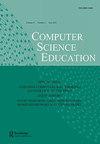两台计算机配对编程:探索一种反馈干预方法来提高小学生的协作能力
IF 2.2
Q1 EDUCATION & EDUCATIONAL RESEARCH
引用次数: 8
摘要
背景和背景研究人员和实践者已经开始将协作纳入编程,因为它在教学和专业方面的好处。然而,年轻的学生需要指导如何在需要大量人际互动和谈判的环境中合作。先前的研究表明,反馈能促进学生富有成效的合作。目的本研究采用干预的方法,探讨指导性反馈在小学生双机结对编程中二元协作的作用。方法采用多研究设计,收集学生二元协作的视频资料。研究1通过编码四对的视频文本定性地探索了二对的协作,这指导了研究2的设计,研究2使用方差分析和非参数测试检查了六对的对话。研究2的结果表明,在考虑的样本组中,接受反馈的学生使用富有成效的谈话类别显著高于对照组。结果讨论了在特定的谈话类别的群体差异。我们的研究强调了在结对编程环境中支持学生的方法,以便他们能够最大限度地从这些经验中获益。本文章由计算机程序翻译,如有差异,请以英文原文为准。
Two-Computer Pair Programming: Exploring a Feedback Intervention to improve Collaborative Talk in Elementary Students
ABSTRACT Background and Context Researchers and practitioners have begun to incorporate collaboration in programming because of its reported instructional and professional benefits. However, younger students need guidance on how to collaborate in environments that require substantial interpersonal interaction and negotiation. Previous research indicates that feedback fosters students’ productive collaboration. Objective This study employs an intervention to explore the role instructor-directed feedback plays on elementary students’ dyadic collaboration during 2-computer pair programming. Method We used a multi-study design, collecting video data on students’ dyadic collaboration. Study 1 qualitatively explored dyadic collaboration by coding video transcripts of four dyads which guided the design of Study 2 that examined conversation of six dyads using MANOVA and non-parametric tests. Findings Result from Study 2 showed that students receiving feedback used productive conversation categories significantly higher than the control condition in the sample group considered. Results are discussed in terms of group differences in specific conversation categories. Implications Our study highlights ways to support students in pair programming contexts so that they can maximize the benefits afforded through these experiences.
求助全文
通过发布文献求助,成功后即可免费获取论文全文。
去求助
来源期刊

Computer Science Education
EDUCATION & EDUCATIONAL RESEARCH-
CiteScore
6.90
自引率
3.70%
发文量
23
期刊介绍:
Computer Science Education publishes high-quality papers with a specific focus on teaching and learning within the computing discipline. The journal seeks novel contributions that are accessible and of interest to researchers and practitioners alike. We invite work with learners of all ages and across both classroom and out-of-classroom learning contexts.
 求助内容:
求助内容: 应助结果提醒方式:
应助结果提醒方式:


